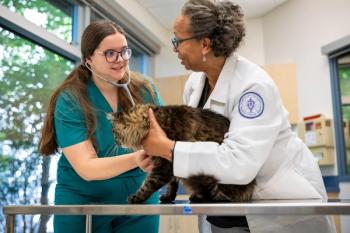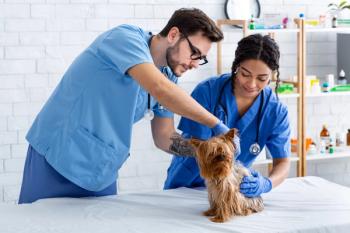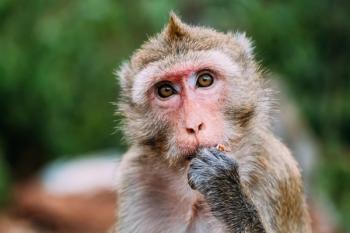
- dvm360 March 2019
- Volume 50
- Issue 3
A medical student walks into a zoo
What happens when a Harvard Medical School student does a rotation at the Franklin Park Zoo? A new One Health opportunity is born.
The Franklin Park Zoo is not where you'd expect to find a Harvard Medical School student, but Gilad Evrony, MD, PhD, is prone to out-of-the-box thinking.
Inspired by Barbara Natterson-Horowitz, MD, and Kathryn Bowers' 2013 book
“I was fascinated by the world of physiology across the animal kingdom, so I called up the zoo in Boston and spoke with the head of veterinary medicine about doing a rotation with them,” Dr. Evrony says.
The call Dr. Evrony made to Eric Baitchman, DVM, DACZM, vice president of animal health and conservation, ended up being serendipitous. Dr. Baitchman was pondering a similar program where medical students would shadow members of the zoo's animal health team.
Once word got out, other students began doing rotations with the zoo as an independent study option. Dr. Baitchman's experience with Dr. Evrony convinced him that this elective could be valuable to other students. So, working with the Harvard Medical School faculty, Dr. Baitchman helped formalize the elective offering in the school's course catalog in 2017.
“It is my sincere hope that as these students continue through their careers, they see beyond the single patient they are treating and see all their patients within the context of the ecosystem they live in,” Dr. Baitchman says. “If the future physicians that we are teaching at the zoo go on to promote the global benefits of biodiversity preservation for human health, it could have a profound impact.”
At its core, One Health-and Harvard Medical School's One Health clinical elective-addresses the connection between humans, animals and the environment. It seeks to create the optimal health for all species within a shared environment.
For Dr. Evrony, the experience opened his eyes to a world of possibility. “When I came back to the world as a medical student, I began to see all these possibilities for research,” he says. “There's so much diversity out there that human doctors don't experience. Metaphorically speaking, the veterinarians and I spoke the same language; we just spoke it with different accents.”
And what if this type of rotation isn't available to medical students at other institutions?
It would seem fairly simple to create opportunities for medical students to interact veterinary students at the same university. But as Marcy Souza, DVM, MPH, DABVP (avian), DACVPM, associate professor in the Department of Public Health at the University of Tennessee, points out, that isn't always possible.
“A lot of veterinary schools are located on agricultural campuses, so veterinary and medical students are geographically separated from each other,” Dr. Souza says. “But I've always wondered what good would come out of combining veterinary and medical schools in the early years.”
“Sixty-five percent of American households live with an animal, so it would be useful for medical students to interface with a regular practitioner,” Dr. Chatfield says. “It makes me think of this case where doctors were having a difficult time diagnosing a patient. While the patient was in the hospital, her dog was taken to the vet and diagnosed with lepto. If the doctors had thought to ask her if she had a dog, her diagnosis might have come sooner. It's all about understanding that patients don't live in a vacuum.”
These real-life connections happen at the Franklin Park Zoo during the One Health Clinical Elective all the time. Students come to Dr. Baitchman during the course of their rotation with unique research proposals. He mentions one memorable proposal that considered using new genomic sequencing technology to better characterize immunologic differences between amphibian species that are sensitive or resistant to chytridiomycosis, a devastating disease that results in the decline of wild amphibians worldwide.
“The massive decline in amphibians in the tropics, and the resultant loss of biodiversity in those ecosystems, has important implications for human and ecosystem health. This is a direct application of One Health,” Dr. Baitchman says.
One Health depends on the collaboration between veterinarians and doctors, whether the collaboration happens during the examination of a Baird's tapir at the Franklin Park Zoo or a simple conversation with a classmate.
Articles in this issue
almost 7 years ago
2019 Hospital of the Year: No appointments? No problem!almost 7 years ago
Service dogs benefits transcend physical assistance, study findsalmost 7 years ago
ProZinc now approved for use in dogsalmost 7 years ago
Veterinary product and company updates, plus more VMX highlightsalmost 7 years ago
The first 3 minutes: Recognizing a horse in shockalmost 7 years ago
Teams, not fees, make equipment greatalmost 7 years ago
U.S. House bill would make animal cruelty a federal offensealmost 7 years ago
Stop telling people what to doalmost 7 years ago
A different kind of roadblockNewsletter
From exam room tips to practice management insights, get trusted veterinary news delivered straight to your inbox—subscribe to dvm360.





